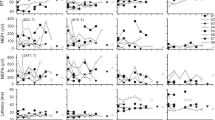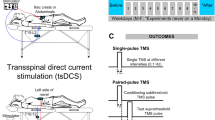Abstract
A four-pulse pattern of transcranial magnetic stimulation (TMS) was compared to traditional dual-pulse TMS for its ability to modulate motor cortical excitability. This novel pattern consisted of a three-pulse train of subthreshold conditioning pulses followed by a suprathreshold test pulse (i.e., SC-T). The intervals between these superconditioning (SC) pulses (1, 3, or 6 ms) and the follow-on test pulse (1, 3, 10, or 25 ms) were varied, and the resultant MEPs were compared to those elicited by: (1) single-pulse TMS; and (2) dual-pulse conditioning-test (C-T) TMS with either short (3 ms) or long (10 ms) intervals to elicit short-interval intracortical inhibition (SICI) or intracortical facilitation (ICF), respectively. Testing included abductor pollicis brevis (APB) and tibialis anterior (TA) in 15 neurologically normal adults. For superconditioning inputs, 10 ms test intervals caused especially strong facilitation of the test MEP, while 1 ms test intervals were particularly effective at causing inhibition of the test response. For both muscles and across all subjects, the most effective of the 12 SC-T inputs tested for causing either facilitation or inhibition was—with rare exception—superior to the dual-pulse TMS input for causing facilitation (i.e., ICF) or inhibition (i.e., SICI), while the overall magnitude of effect was more pronounced in APB compared to TA. Nevertheless, after normalization, the impact of a superconditioning input train on the test MEP was similar in APB and TA muscles, suggesting similar mechanisms of action. Limited findings from a single subject with amyotrophic lateral sclerosis (ALS) are included to further illustrate the potential advantages of using a train of conditioning pulses preceding a TMS test pulse to selectively investigate abnormal motor cortical excitatory and inhibitory circuitry.






Similar content being viewed by others
References
Attarian S, Vedel JP, Pouget J, Schmied A (2006) Cortical versus spinal dysfunction in amyotrophic lateral sclerosis. Muscle Nerve 33:677–690. https://doi.org/10.1002/mus.20519
Attarian S, Pouget J, Schmied A (2009) Changes in cortically induced inhibition in amyotrophic lateral sclerosis with time. Muscle Nerve 39:310–317
Barker AT, Jalinous R, Freston IL (1985) Non-invasive magnetic stimulation of human motor cortex. Lancet i:1106–1107
Bawa P, Calancie B (2004) Rate-coding of spinal motoneurons with high frequency magnetic stimulation of human motor cortex. Can J Physiol Pharmacol 82:740–748
Calancie B (2017) Intraoperative neuromonitoring and alarm criteria for judging MEP responses to transcranial electric stimulation: the threshold-level method. J Clin Neurophysiol 34:12–21. https://doi.org/10.1097/WNP.0000000000000339
Calancie B, Nordin M, Wallin R, Hagbarth KE (1987) Motor-unit responses in human wrist flexor and extensor muscles to transcranial cortical stimuli. J Neurophysiol 58:1168–1185
Calancie B, Harris W, Broton JG, Alexeeva N, Green BA (1998) “Threshold-level” multipulse transcranial electrical stimulation of motor cortex for intraoperative monitoring of spinal motor tracts: description of method and comparison to somatosensory evoked potential monitoring. J Neurosurg 88:457–470
Calancie B, Alexeeva N, Broton JG, Suys S, Hall A, Klose KJ (1999) Distribution and latency of muscle responses to transcranial magnetic stimulation of motor cortex after spinal cord injury in humans. J Neurotrauma 16:49–67
Caramia MD, Palmieri MG, Desiato MT, Iani C, Scalise A, Telera S, Bernardi G (2000) Pharmacologic reversal of cortical hyperexcitability in patients with ALS. Neurology 54:58–64
Chen R, Cros D, Curra A et al (2008) The clinical diagnostic utility of transcranial magnetic stimulation: report of an IFCN committee. Clin Neurophysiol 119:504–532
Di Lazzaro V, Restuccia D, Oliviero A et al (1998) Magnetic transcranial stimulation at intensities below active motor threshold activates intracortical inhibitory circuits. Exp Brain Res 119:265–268
Di Lazzaro V, Pilato F, Oliviero A et al (2006) Origin of facilitation of motor-evoked potentials after paired magnetic stimulation: direct recording of epidural activity in conscious humans. J Neurophysiol 96:1765–1771
Dimyan MA, Cohen LG (2010) Contribution of transcranial magnetic stimulation to the understanding of functional recovery mechanisms after stroke. Neurorehabil Neural Repair 24:125–135
Edwardson MA, Lucas TH, Carey JR, Fetz EE (2013) New modalities of brain stimulation for stroke rehabilitation. Exp Brain Res 224:335–358
Enterzari-Taher M, Eisen A, Stewart H, Nakajima M (1997) Abnormalities of cortical inhibitory neurons in amyotrophic lateral sclerosis. Muscle Nerve 20:65–71
Fisher RJ, Nakamura Y, Bestmann S, Rothwell JC, Bostock H (2002) Two phases of intracortical inhibition revealed by transcranial magnetic threshold tracking. Exp Brain Res 143:240–248
Florian J, Muller-Dahlhaus M, Liu Y, Ziemann U (2008) Inhibitory circuits and the nature of their interactions in the human motor cortex a pharmacological TMS study. J Physiol 586:495–514
Groppa S, Oliviero A, Eisen A et al (2012) A practical guide to diagnostic transcranial magnetic stimulation: report of an IFCN committee. Clin Neurophysiol 123:858–882
Hanajima R, Ugawa Y, Terao Y, Sakai K, Furubayashi T, Machii K, Kanazawa I (1998) Paired-pulse magnetic stimulation of the human motor cortex: differences among I waves. J Physiol 509(Pt 2):607–618
Hanajima R, Terao Y, Hamada M et al (2009) Forty-hertz triple-pulse stimulation induces motor cortical facilitation in humans. Brain Res 1296:15–23. https://doi.org/10.1016/j.brainres.2009.08.008
Huang YZ, Rothwell JC (2004) The effect of short-duration bursts of high-frequency, low-intensity transcranial magnetic stimulation on the human motor cortex. Clin Neurophysiol 115:1069–1075
Huynh W, Simon NG, Grosskreutz J, Turner MR, Vucic S, Kiernan MC (2016) Assessment of the upper motor neuron in amyotrophic lateral sclerosis. Clin Neurophysiol 127:2643–2660
Ilic TV, Meintzschel F, Cleff U, Ruge D, Kessler KR, Ziemann U (2002) Short-interval paired-pulse inhibition and facilitation of human motor cortex: the dimension of stimulus intensity. J Physiol 545:153–167
Jones SJ, Harrison R, Koh KF, Mendoza N, Crockard HA (1996) Motor evoked potential monitoring during spinal surgery: responses of distal limb muscles to transcranial cortical stimulation with pulse trains. Electroencephalogr Clin Neurophysiol 100:375–383
Kujirai T, Caramia MD, Rothwell JC et al (1993) Corticocortical inhibition in human motor cortex. J Physiol 471:501–519
Lackmy A, Marchand-Pauvert V (2010) The estimation of short intra-cortical inhibition depends on the proportion of spinal motoneurones activated by corticospinal inputs. Clin Neurophysiol 121:612–621
Martin PG, Hudson AL, Gandevia SC, Taylor JL (2009) Reproducible measurement of human motoneuron excitability with magnetic stimulation of the corticospinal tract. J Neurophysiol 102:606–613
Mills KR (1995) Motor neuron disease. Studies of the corticospinal excitation of single motor neurons by magnetic brain stimulation. Brain 118(Pt 4):971–982
Murakami T, Muller-Dahlhaus F, Lu MK, Ziemann U (2012) Homeostatic metaplasticity of corticospinal excitatory and intracortical inhibitory neural circuits in human motor cortex. J Physiol 590:5765–5781
Ni Z, Chen R (2008) Short-interval intracortical inhibition: a complex measure. Clin Neurophysiol 119:2175–2176
Nitsche MA, Muller-Dahlhaus F, Paulus W, Ziemann U (2012) The pharmacology of neuroplasticity induced by non-invasive brain stimulation: building models for the clinical use of CNS active drugs. J Physiol 590:4641–4662
Pechstein U, Cedzich C, Nadstawek J, Schramm J (1996) Transcranial high-frequency repetitive electrical stimulation for recording myogenic motor evoked potentials with the patient under general anesthesia. Neurosurgery 39:335–344
Peurala SH, Muller-Dahlhaus JF, Arai N, Ziemann U (2008) Interference of short-interval intracortical inhibition (SICI) and short-interval intracortical facilitation (SICF). Clin Neurophysiol 119:2291–2297. https://doi.org/10.1016/j.clinph.2008.05.031
Reis J, Swayne OB, Vandermeeren Y et al (2008) Contribution of transcranial magnetic stimulation to the understanding of cortical mechanisms involved in motor control. J Physiol 586:325–351
Rossini PM, Barker AT, Berardelli A et al (1994) Non-invasive electrical and magnetic stimulation of the brain, spinal cord and roots: basic principles and procedures for routine clinical application. Report of an IFCN committee. Electroencephalogr Clin Neurophysiol 91:79–92
Rothwell JC, Day BL, Thompson PD, Kujirai T (2009) Short latency intracortical inhibition: one of the most popular tools in human motor neurophysiology. J Physiol 587:11–12
Shimizu T, Filippi MM, Palmieri MG, Oliveri M, Vernieri F, Pasqualetti P, Rossini PM (1999) Modulation of intracortical excitability for different muscles in the upper extremity: paired magnetic stimulation study with focal versus non-focal coils. Clin Neurophysiol 110:575–581
Tokimura H, Ridding MC, Tokimura Y, Amassian VE, Rothwell JC (1996) Short latency facilitation between pairs of threshold magnetic stimuli applied to human motor cortex. Electroencephalogr Clin Neurophysiol 101:263–272
Triggs WJ, Menkes D, Onorato J et al (1999) Transcranial magnetic stimulation identifies upper motor neuron involvement in motor neuron disease. Neurology 53:605–611
Truffert A, Alisauskiene M, Vaiciene N, Magistris MR (2007) A clinical study of corticospinal and peripheral conductions to proximal lower limb muscles. Clin Neurophysiol 118:1824–1834
Uozumi T, Tsuji S, Murai Y (1991) Motor potentials evoked by magnetic stimulation of the motor cortex in normal subjects and patients with motor disorders. Electroencephalogr Clin Neurophysiol 81:251–256
Valls-Sol J, Pascual-Leone A, Wassermann EM, Hallett M (1992) Human motor evoked responses to paired transcranial magnetic stimuli. Electroencephalogr Clin Neurophysiol 85:355–364
Vucic S, Kiernan MC (2006) Novel threshold tracking techniques suggest that cortical hyperexcitability is an early feature of motor neuron disease. Brain 129:2436–2446. https://doi.org/10.1093/brain/awl172
Vucic S, Cheah BC, Yiannikas C, Kiernan MC (2011) Cortical excitability distinguishes ALS from mimic disorders. Clin Neurophysiol 122:1860–1866
Wagle-Shukla A, Ni Z, Gunraj CA, Bahl N, Chen R (2009) Effects of short interval intracortical inhibition and intracortical facilitation on short interval intracortical facilitation in human primary motor cortex. J Physiol 587:5665–5678
Wassermann EM (1998) Risk and safety of repetitive transcranial magnetic stimulation: report and suggested guidelines from the international workshop on the safety of repetitive transcranial magnetic stimulation, June 5–7, 1996. Electroencephalogr Clin Neurophysiol 108:1–16
Wassermann EM (2000) Side effects of repetitive transcranial magnetic stimulation. Depress Anxiety 12:124–129
Wassermann EM, Lisanby SH (2001) Therapeutic application of repetitive transcranial magnetic stimulation: a review. Clin Neurophysiol 112:1367–1377
Werhahn KJ, Kunesch E, Noachtar S, Benecke R, Classen J (1999) Differential effects on motorcortical inhibition induced by blockade of GABA uptake in humans. J Physiol 517(Pt 2):591–597
Yokota T, Yoshino A, Inaba A, Saito Y (1996) Double cortical stimulation in amyotrophic lateral sclerosis. J Neurol Neurosurg Psychiatry 61:596–600
Ziemann U (2004) TMS and drugs. Clin Neurophysiol 115:1717–1729
Ziemann U, Rothwell JC, Ridding MC (1996) Interaction between intracortical inhibition and facilitation in human motor cortex. J Physiol 496:873–881
Ziemann U, Winter M, Reimers CD, Reimers K, Tergau F, Paulus W (1997) Impaired motor cortex inhibition in patients with amyotrophic lateral sclerosis. Evidence from paired transcranial magnetic stimulation. Neurology 49:1292–1298
Acknowledgements
The authors thank Parveen Bawa for her helpful comments regarding this manuscript. This work was supported by the Dept. of Neurosurgery at Upstate Medical University.
Author information
Authors and Affiliations
Corresponding author
Ethics declarations
Conflict of interest
The authors declare they have no conflict of interest.
Ethical approval
All procedures performed were in accordance with the ethical standards of Upstate Medical University and with the 1964 Helsinki declaration and its later amendments.
Informed consent
Informed consent was obtained from all individual participants included in the study.
Rights and permissions
About this article
Cite this article
Calancie, B., Wang, D., Young, E. et al. Four-pulse transcranial magnetic stimulation using multiple conditioning inputs. Normative MEP responses. Exp Brain Res 236, 1205–1218 (2018). https://doi.org/10.1007/s00221-018-5212-8
Received:
Accepted:
Published:
Issue Date:
DOI: https://doi.org/10.1007/s00221-018-5212-8




